#Docker learning tutorial
Explore tagged Tumblr posts
Text
Nodejs Microservice & MongoDB in Docker Container | Learn Express Mongoose Nodejs Microservices in Docker
Full Video Link https://youtu.be/ltNr8Meob4g Hello friends, new #video on #nodejs #microservices in #docker #container with #mongodb in #docker #container #tutorial for #api #developer #programmers with #examples is published on #codeonedig
In this video we will create Nodejs microservices running in docker container with mongodb running in docker container. We will use Express & mongoose modules in Nodejs to create microservices. I will show how to download MongoDB image from DockerHub repository. How to run mongodb image in docker container. I will explain how to connect nodejs microservices to mongodb running in docker container.…
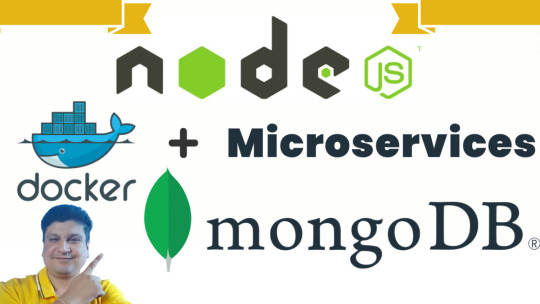
View On WordPress
#docker#docker container#docker microservice example#docker microservices#docker microservices nodejs#docker microservices tutorial#docker mongodb#docker tutorial#learn docker#microservice mongo#mongodb docker#node js express#node js mongoose#nodejs microservice#nodejs microservice architecture#nodejs microservice docker#nodejs microservice example#nodejs microservice mongodb#nodejs microservice project#nodejs microservices tutorial#what is docker
0 notes
Text
how to make cool blobby turing patterns in photoshop

i'll preface with i learned the basic loop from skimming a tutorial on youtube, but as someone who prefers written tutorials i'm sure many would appreciate one! also, the second part of this is some of the visual effects i figured out on my own using blending modes and stuff.
i'm using photoshop CS4 on a mac so some buttons and stuff might be in different places on windows and newer photoshop versions but all the actions are the same. my canvas is 1000x1000 pixels.
UPDATES (i'm hoping these'll show up whenever you open the readmore?)
it's possible to do something similar in krita using this plugin, made by the love @arcaedex
it's also possible to do this in photopea, a free browser alternative to photoshop! the results are pretty much identical.
FIRST off you wanna get or make a black and white image of some kind. it has to be one layer. can be noise, a photo, a bunch of lines, whatever. here's mine, just some quick airbrush lines:

now find the actions tab. idk what it looks like in newer versions of photoshop but you probably won't need to dig!
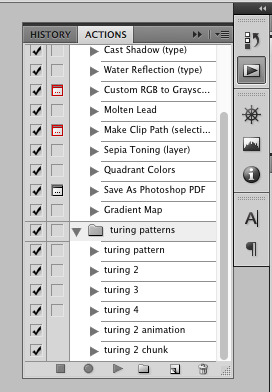
hit the little page thingy to make a new pattern. once you hit 'record', it'll record everything you do. the little square 'stop' icon will end it.
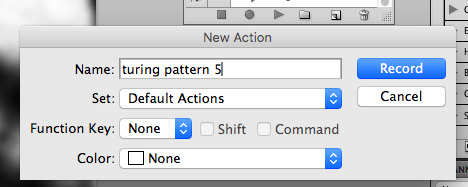
now you want to do a high pass filter. you can mess around with the radius to change the size of your squiggles, but the tutorial had it set to 6. experiment!

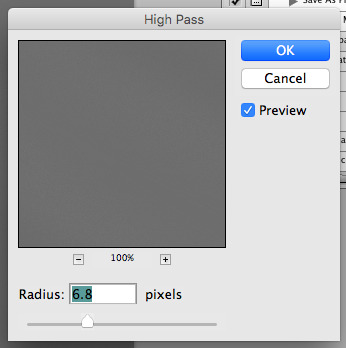
now add the 'threshold' adjustment layer. i use the adjustments tab but i think there's also a dropdown menu somewhere. keep it at the default, 128. merge it down. (control or command + E or you can right click it like some kind of weirdo)

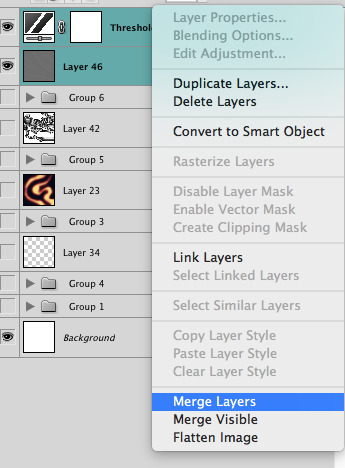
and finally, the gaussian blur! the radius of this affects the shape and size of your squiggles as well. i like to keep it around 4.5 but you can mess around with that too.


after that, hit 'stop' on the action you're recording, and then repeat it a bunch of times using the 'play' button, until you have something you like, like this:

WOW!! that was fun!! and only a little tedious thanks to the power of macros. anyway, here's some fun layer blending stuff i like to do. it's with a different pattern cause i made this bit first.
anyway, using a black and white gradient (or a grey base that you do black and white airbrush on), make a layer with the vivid light. this will make the blobs look thicker or thinner.




then, for cool colors, do a gradient map adjustment layer over that:

and finally, my best friend, the overlay layer. just using a gradient here bc i'm lazy, but feel free to experiment with brushes, colors, and blending modes!
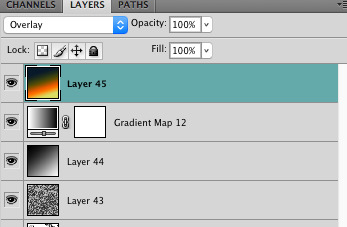

NOW GO. MAKE COOL SHIT WITH THE POWER OF MATH. AND SEND IT TO ME
also these are not hard and fast rules PLEASE mess around with them to see what kind of weird shit you can make. here's a gif. as you can see i added some random airblush blobs in the middle of it, for fun.

933 notes
·
View notes
Note
More in-depth thoughts on making the switch to csp? I’ve been debating it for a good while now and would love a secondary opinion! Also thoughts on having to use new brushes after the switch? <3
I'd been using krita since 2012, so it felt like i'd be cheating on it if i switched to csp. I think it was a combination of the fact that i know krita very well by now, plus i had made a whole bunch of pens on there and i'm pretty sure i can't bring them with me to csp, etc. oh and also the fact that krita is free. That was major for me, because i grew up without a lot of money and so i learned to work around getting expensive art supplies and such
However... Csp is totally worth it. It's been a process figuring out the set up and configurations, because it's not as simplified as krita (though krita has these same tools, some of them are different in either program. Some things are just two clicks in krita, and take longer in csp, while other things are a fifteen step process and krita, and csp already has an entire docker there waiting for you). But it's not too hard and it's fairly easy to look up anything i have questions about. They would be tied when it comes to set up, if not for the fact that csp has set ups ready to go for comics that feels a lot easier to work with. So that's win 1 for csp
Win 2 for csp was the brushes and stamps, etc that are on there. It takes a lot of getting used to, and i'm not a fan of the stabilization so far (not exactly sure if there is another option yet, but from what i can tell, individual brushes have stabilization options. Not bad, until i struggle to find an overall stabilization option, if there is one). In krita you can just hit "E" and it will turn whatever brush you're using into an eraser with the same texture and settings as the brush, and pressing "E" again turns it back. But in csp, erasers are limited and i don't like them very much.
But!! Texture,,, i'm a big fan of the everything else about the brushes. it kind of feels like working with actual physical materials (as much as it can). Watercolor mixes and acts like it's on real paper, etc etc. i'm really liking the pens that i found (because in csp, you really should be using the assets page to find brushes, or look up tutorials to make your own, but the default brushes are still amazing if you don't want to adventure out!). Krita is very limited on these. Csp sort of gives the effect of physical media and texture, whereas krita always has a digital look to it. If that makes sense? I'm not saying csp doesn't look digital, but it just has way more of that oomph that i've been wanting for my art for years now
All in all, i can say that i still recommend Krita, especially for beginners, and especially for people who can't afford to spend money on a program. It's still a VERY good place to draw and i'll likely still use it. It's a great starter and honestly, you don't have to make a change if you like it. But csp is also very much worth the money and you won't regret it
#im not at home rn so i can't show my pens that i like#but someone remind me later today and i can try to reblog this with a list#and some examples of doodles#clip studio paint#csp art#krita#krita art#digital art#art#erinwantstowrite#it's got yummy texture#and the more i use it the more comfortable i get with it#it's a learning curve but it's got no bumps in the road#thank you for the ask!
55 notes
·
View notes
Text
Containerizing Node.js Apps with Docker & Docker Compose
1. Introduction Containerization has revolutionized the way we develop, deploy, and manage applications. It ensures consistency across different environments, simplifies deployment, and optimizes resource usage. In this tutorial, we will focus on containerizing Node.js applications using Docker and Docker Compose. What You Will Learn: – Creating Docker images for Node.js applications – Using…
0 notes
Text
Best Online Coding Bootcamps for Beginners (2025 Guide)
Coding Bootcamps in 2025: A Fast-Track Path to Tech Careers

By 2025, coding will evolve beyond its technical roots, opening academic pathways in areas like web development, data science, and automation. Online coding bootcamps have emerged as an affordable, faster alternative to traditional degrees, offering practical, job-ready training. Platforms like Class Bazaar help learners identify top-rated programs with job guarantees, ensuring their investment leads to real career growth.
Why Choose an Online Coding Bootcamp? Online bootcamps are ideal for those switching careers or starting fresh. They provide flexibility to learn from anywhere, with self-paced or part-time options perfect for professionals, students, and parents. Unlike scattered tutorials, bootcamps follow a structured curriculum with real-world projects, mentorship, and career support including portfolio building and interview preparation.
What to Look for in a Bootcamp:
Beginner-friendly curriculum with no prior experience required
Real-world projects to build a strong GitHub portfolio
Access to expert mentors and peer support
Job placement support or money-back guarantees
Transparent pricing with flexible payment plans or scholarships
Top Online Coding Bootcamps for Beginners (2025):
Full-Stack Web Development by Udemy – Teaches HTML, CSS, JavaScript, Node.js, and more at your pace.
Python for Everybody by Coursera (University of Michigan) – Great for learning coding basics and data projects.
Google IT Automation with Python (Coursera) – A job-focused course for IT beginners with hands-on learning and Google certification.
IBM Full Stack Software Developer (Coursera) – Covers front-end to DevOps with tools like React, Python, and Docker.
Meta Front-End Developer Certificate (Coursera) – Learn HTML, CSS, JavaScript, and React, guided by Meta engineers.
Tips for Succeeding in a Bootcamp:
Treat it like a job: set daily study hours and stay focused
Practice coding challenges on LeetCode or HackerRank
Join online communities for support and collaboration
Build personal projects to apply your learning
Showcase your work on GitHub to boost your job profile
FAQs
Are bootcamps worth it in 2025? Yes—they're fast, affordable, and aligned with in-demand tech roles.
Do I need experience? No—many bootcamps are designed for beginners.
Duration? Typically 3–6 months, with some self-paced options.
Jobs after bootcamp? Roles include web developer, QA tester, data analyst, and IT support.
Job guarantees? Many offer support or refunds if you're not employed within 6 months.
Conclusion: Online coding bootcamps in 2025 offer accessible, job-focused training in web development, automation, and software engineering. Whether you’re a beginner or changing careers, explore the best bootcamps on Class Bazaar to start your journey into tech.
0 notes
Text
#DockerTutorial#LearnDocker#DevOpsTutorial#DockerForBeginners#DockerBasics#DockerTraining#DockerCompose
0 notes
Text
This Week in Rust 598
Hello and welcome to another issue of This Week in Rust! Rust is a programming language empowering everyone to build reliable and efficient software. This is a weekly summary of its progress and community. Want something mentioned? Tag us at @thisweekinrust.bsky.social on Bluesky or @ThisWeekinRust on mastodon.social, or send us a pull request. Want to get involved? We love contributions.
This Week in Rust is openly developed on GitHub and archives can be viewed at this-week-in-rust.org. If you find any errors in this week's issue, please submit a PR.
Want TWIR in your inbox? Subscribe here.
Updates from Rust Community
Official
Announcing rustup 1.28.2
Project/Tooling Updates
Announcing Malai - Share your dev server (and more) over P2P
Streaming data analytics, Fluvio 0.17.2 release
Leptos v0.8.0
This Month in Redox - April 2025
Observations/Thoughts
Automatic interleaving of high-level concurrent operations
Flattening Rust's Learning Curve
The Evolution of Rust
std::mem is... interesting
[audio] Svix with Tom Hacohen
Rust Walkthroughs
Authentication with Axum
Newtyped Indices are Proofs
What is my fuzzer doing?
A Rust API Inspired by Python, Powered by Serde
How to create small and secure Docker images for Rust (FROM scratch)
[video] Rust + SQLite: Complete Tutorial (Schema, CRUD, JSON & Async)
Research
An Interactive Debugger for Rust Trait Errors
RustAssistant: Using LLMs to Fix Compilation Errors in Rust Code
Miscellaneous
Memory-safe sudo to become the default in Ubuntu
How To Get A Rust Job Part I: Companies Already Using Rust
GOSIM Spotlight Finalists at RustWeek
Crate of the Week
This week's crate is structstruck, a proc-macro crate for enabling nested struct/enum definitions.
Thanks to Julius Michaelis for the self-suggestion!
Please submit your suggestions and votes for next week!
Calls for Testing
An important step for RFC implementation is for people to experiment with the implementation and give feedback, especially before stabilization.
If you are a feature implementer and would like your RFC to appear in this list, add a call-for-testing label to your RFC along with a comment providing testing instructions and/or guidance on which aspect(s) of the feature need testing.
No calls for testing were issued this week by Rust, Rust language RFCs or Rustup.
Let us know if you would like your feature to be tracked as a part of this list.
RFCs
Rust
Rustup
If you are a feature implementer and would like your RFC to appear on the above list, add the new call-for-testing label to your RFC along with a comment providing testing instructions and/or guidance on which aspect(s) of the feature need testing.
Call for Participation; projects and speakers
CFP - Projects
Always wanted to contribute to open-source projects but did not know where to start? Every week we highlight some tasks from the Rust community for you to pick and get started!
Some of these tasks may also have mentors available, visit the task page for more information.
* Hyperswitch - Move connector-specific utility functions to respective connector modules * Hyperswitch - Refactor ACI connector to reuse utilities from utils.rs * Hyperswitch - Analyze and remove unused functions in connector/utils.rs * rama - add ffi/rama-rhai: support ability to use services and layers written in rhai * rama - support (TLS) peetprint in rama-net fingerprinting * rama - support akamai h2 passive fingerprint and expose in echo + fp services * rama - add into_stream to BodyExtractExt trait
If you are a Rust project owner and are looking for contributors, please submit tasks here or through a PR to TWiR or by reaching out on X (formerly Twitter) or Mastodon!
CFP - Events
Are you a new or experienced speaker looking for a place to share something cool? This section highlights events that are being planned and are accepting submissions to join their event as a speaker.
No Calls for papers or presentations were submitted this week.
If you are an event organizer hoping to expand the reach of your event, please submit a link to the website through a PR to TWiR or by reaching out on X (formerly Twitter) or Mastodon!
Updates from the Rust Project
447 pull requests were merged in the last week
Compiler
handle paren in macro expand for let-init-else expr
implement or-patterns for pattern types
initial support for dynamically linked crates
mir-opt: execute MatchBranchSimplification after GVN
refactor rustc_on_unimplemented's filter parser
perf: optimize the codegen for Span::from_expansion
perf: delay checking of #[rustc_no_implicit_autorefs] in autoref lint
perf: simplify LazyAttrTokenStream
perf: use a closure instead of three chained iterators
transmutability: merge contiguous runs with a common destination
transmutability: uninit transition matches unit byte only
Library
avoid redundant WTF-8 checks in PathBuf
delegate to inner vec::IntoIter from env::ArgsOs
implement Iterator::last for vec::IntoIter
stabilize ptr::swap_nonoverlapping in const
stabilize select_unpredictable
streamline the format macro
Cargo
cargo add: suggest similarly named features
in package-workspace, keep dev-dependencies if they have a version
Rustdoc
fix doctest heuristic for main fn wrapping
Rustfmt
also allow bool literals as first item of let chain
Clippy
don't warn about unloaded crates
fix collapsible_if false positive on block stmt before expr
fix manual_unwrap_or_default false positive on ref binding
fix: manual_slice_fill false positive on IndexMut overload
fix: unused_async false positive on default impl
gate collapsible_if let_chains lints on edition 2024 and MSRV
Rust-Analyzer
add PGO support to install
better handle parallelism in cache priming
disable fixpoint for variance computation temporarily
add an assist to unwrap a type with a generic arg
correct assoc ty bound var starting index
correct span info for mir::Operand
don't panic on some weird code
fix move_bounds assists not working for lifetimes
fix incorrect handling of unresolved non-module imports in name resolution
fix proc-macro API creating malformed negative literals
implement mut to const ptr cast for method resolution
improve parser recovery a bit
negative nums in concat! expansion
remove unnecessary token length check for macros in renaming
improve the let code snippet
render more lifetimes
support environment variable CARGO_MANIFEST_PATH
Rust Compiler Performance Triage
A relatively noisy week due to addition of new benchmarks as part of our 2025 benchmark update, and a number of large regressions in a rollup landing late in the week (and so not yet investigated).
Triage done by @simulacrum. Revision range: 25cdf1f6..62c5f58f
2 Regressions, 2 Improvements, 6 Mixed; 3 of them in rollups 31 artifact comparisons made in total
Full report here.
Approved RFCs
Changes to Rust follow the Rust RFC (request for comments) process. These are the RFCs that were approved for implementation this week:
No RFCs were approved this week.
Final Comment Period
Every week, the team announces the 'final comment period' for RFCs and key PRs which are reaching a decision. Express your opinions now.
Tracking Issues & PRs
Rust
Temporary lifetime extension through tuple struct and tuple variant constructors
Stabilize the avx512 target features
Make missing_fragment_specifier an unconditional error
Error on recursive opaque ty in HIR typeck
Add std::io::Seek instance for std::io::Take
remove intrinsics::drop_in_place
Stabilize tcp_quickack
Change the desugaring of assert! for better error output
[Tracking Issue for non_null_from_ref](https://github.com/rust-lang/rust/issues/130823)
Make well-formedness predicates no longer coinductive
Fix parameter order for _by() variants of min / max/ minmax in std::cmp
Finalize repeat expr inference behaviour with inferred repeat counts
Implement (part of) ACP 429: add DerefMut to Lazy[Cell/Lock]
Other Areas
Cargo
Stabilize doctest-xcompile
Rust RFCs
RFC: map_or_default in Option and Result
No Items entered Final Comment Period this week for Language Reference, Language Team or Unsafe Code Guidelines.
Let us know if you would like your PRs, Tracking Issues or RFCs to be tracked as a part of this list.
New and Updated RFCs
RFC: enable derive(From) for single-field structs
#![register_{attribute,lint}_tool]
RFC: Add an attribute for raising the alignment of various items
Upcoming Events
Rusty Events between 2025-05-07 - 2025-06-04 🦀
Virtual
2025-05-07 | Virtual (Indianapolis, IN, US) | Indy Rust
Indy.rs - with Social Distancing
2025-05-07 | Virtual (Rotterdam, NL) | Bevy Game Development
Bevy Meetup #10
2025-05-08 | Virtual (Berlin, DE) | Rust Berlin
Rust Hack and Learn
2025-05-08 | Virtual (Girona, ES) | Rust Girona
Sessió setmanal de codificació / Weekly coding session
2025-05-08 | Virtual (Tel Aviv-Yafo, IL) | Rust 🦀 TLV
שיחה חופשית ווירטואלית על ראסט
2025-05-08 | Virtual (Zürich, CH) | Rust Zürisee
🦀 Celebrating 10 years of Rust 1.0 (co-event with berline.rs) 🦀
2025-05-10 | Virtual | Leptos Community
Leptos Meetup: 0.8 Release and Server Fn Websockets Demo
2025-05-11 | Virtual (Dallas, TX, US) | Dallas Rust User Meetup
Rust Readers Discord Discussion: Async Rust
2025-05-11 | Virtual (Dallas, TX, US) | Dallas Rust User Meetup
Rust Readers Discord Discussion: Async Rust
2025-05-13 | Virtual (Dallas, TX, US) | Dallas Rust User Meetup
Second Tuesday
2025-05-15 | Hybrid (Redmond, WA, US) | Seattle Rust User Group
May, 2025 SRUG (Seattle Rust User Group) Meetup
2025-05-15 | Virtual (Joint Meetup, Europe + Israel) | Rust Berlin, Rust Paris, London Rust Project Group, Rust Zürisee, Rust TLV, Rust Nürnberg, Rust Munich, Rust Aarhus, lunch.rs
🦀 Celebrating 10 years of Rust 1.0 🦀
2025-05-15 | Virtual (Girona, ES) | Rust Girona
Sessió setmanal de codificació / Weekly coding session
2025-05-18 | Virtual (Dallas, TX, US) | Dallas Rust User Meetup
Rust Readers Discord Discussion: Async Rust
2025-05-19 | Virtual (Tel Aviv-Yafo, IL) | Rust 🦀 TLV
Tauri: Cross-Platform desktop applications with Rust and web technologies
2025-05-20 | Virtual (London, UK) | Women in Rust
Threading through lifetimes of borrowing - the Rust way
2025-05-20 | Virtual (Tel Aviv, IL) | Code Mavens 🦀 - 🐍 - 🐪
Rust at Work a conversation with Ran Reichman Co-Founder & CEO of Flarion
2025-05-20 | Virtual (Washington, DC, US) | Rust DC
Mid-month Rustful
2025-05-21 | Hybrid (Vancouver, BC, CA) | Vancouver Rust
Rust Study/Hack/Hang-out
2025-05-22 | Virtual (Berlin, DE) | Rust Berlin
Rust Hack and Learn
2025-05-22 | Virtual (Girona, ES) | Rust Girona
Sessió setmanal de codificació / Weekly coding session
2025-05-25 | Virtual (Dallas, TX, US) | Dallas Rust User Meetup
Rust Readers Discord Discussion: Async Rust
2025-05-25 | Virtual (Dallas, TX, US) | Dallas Rust User Meetup
Rust Readers Discord Discussion: Async Rust
2025-05-27 | Virtual (Dallas, TX, US) | Dallas Rust User Meetup
Fourth Tuesday
2025-05-27 | Virtual (Tel Aviv, IL) | Code Mavens 🦀 - 🐍 - 🐪
Rust at Work - conversation with Eli Shalom & Igal Tabachnik of Eureka Labs
2025-05-29 | Virtual (Nürnberg, DE) | Rust Nuremberg
Rust Nürnberg online
2025-06-01 | Virtual (Dallas, TX, US) | Dallas Rust User Meetup
Rust Readers Discord Discussion: Async Rust
2025-06-04 | Virtual (Indianapolis, IN, US) | Indy Rust
Indy.rs - with Social Distancing
Asia
2025-05-17 | Delhi, IN | Rust Delhi
Rust Delhi Meetup #10
2025-05-24 | Bangalore/Bengaluru, IN | Rust Bangalore
May 2025 Rustacean meetup
Europe
2025-05-07 | Girona, ES | Rust Girona
Rust Girona Hack & Learn 05 2025
2025-05-07 | Köln, DE | Rust Cologne
Rust in May: FFI
2025-05-07 | Madrid, ES | MadRust
VII Lenguajes, VII Perspectivas, I Problema
2025-05-07 | Oxford, UK | Oxford Rust Meetup Group
Oxford Rust and C++ social
2025-05-08 | Gdansk, PL | Rust Gdansk
Rust Gdansk Meetup #8
2025-05-08 | London, UK | London Rust Project Group
Adopting Rust (Hosted by Lloyds bank)
2025-05-12 | Amsterdam, NL | RustNL
Bowling at Rust Week
2025-05-12 | Amsterdam, NL | RustNL
Create your rusty steel Rust logo!
2025-05-12 | Amsterdam, NL | RustNL
Walking Tour around Utrecht - Monday (afternoon)
2025-05-12 | Amsterdam, NL | RustNL
Walking Tour around Utrecht - Monday
2025-05-13 | Amsterdam, NL | RustNL
RustWeek 2025 announcement
2025-05-13 - 2025-05-17 | Utrecht, NL | Rust NL
RustWeek 2025
2025-05-14 | Reading, UK | Reading Rust Workshop
Reading Rust Meetup
2025-05-15 | Oslo, NO | Rust Oslo
Rust 10-year anniversary @ Appear
2025-05-16 | Amsterdam, NL | RustNL
Rust Week Hackathon
2025-05-16 | Utrecht, NL | Rust NL Meetup Group
RustWeek Hackathon
2025-05-17 | Amsterdam, NL | RustNL
Walking Tour around Utrecht - Saturday
2025-05-20 | Aarhus, DK | Rust Aarhus
Hack Night - Robot Edition
2025-05-20 | Leipzig, SN, DE | Rust - Modern Systems Programming in Leipzig
Topic TBD
2025-05-22 | Augsburg, DE | Rust Augsburg
Rust meetup #13
2025-05-22 | Bern, CH | Rust Bern
2025 Rust Talks Bern #3 @zentroom
2025-05-22 | Paris, FR | Rust Paris
Rust meetup #77
2025-05-22 | Stockholm, SE | Stockholm Rust
Rust Meetup @UXStream
2025-05-27 | Basel, CH | Rust Basel
Rust Meetup #11 @ Letsboot Basel
2025-05-29 | Oslo, NO | Rust Oslo
Rust Hack'n'Learn at Kampen Bistro
2025-06-04 | München, DE | Rust Munich
Rust Munich 2025 / 2 - Hacking Evening
2025-06-04 | Oxford, UK | Oxford Rust Meetup Group
Oxford Rust and C++ social
North America
2025-05-07 | Chicago, IL, US | Chicago Rust Meetup
Rust Happy Hour
2025-05-08 | México City, MX | Rust MX
Calculando con el compilador: Compiler time vs Run time. Introducción a uv
2025-05-08 | Portland, OR, US | PDXRust
Apache DataFusion: A Fast, Extensible, Modular Analytic Query Engine in Rust
2025-05-11 | Boston, MA, US | Boston Rust Meetup
Porter Square Rust Lunch, May 11
2025-05-13 | New York, NY, US | Rust NYC
Multi-Platform App in Rust @ Warp.dev && Verifying Rust's Stdlib @ CMU
2025-05-15 | Mountain View, CA, US | Hacker Dojo
RUST MEETUP at HACKER DOJO
2025-05-15 | Nashville, TN, US | Music City Rust Developers
Using Rust For Web Series 2 : Why you, Yes You. Should use Hyperscript!
2025-05-15 | Hybrid (Redmond, WA, US) | Seattle Rust User Group
May, 2025 SRUG (Seattle Rust User Group) Meetup
2025-05-20 | San Francisco, CA, US | San Francisco Rust Study Group
Rust Hacking in Person
2025-05-21 | Hybrid (Vancouver, BC, CA) | Vancouver Rust
Rust Study/Hack/Hang-out
2025-05-28 | Austin, TX, US | Rust ATX
Rust Lunch - Fareground
2025-05-29 | Atlanta, GA, US | Rust Atlanta
Rust-Atl
South America
2025-05-28 | Montevideo, DE, UY | Rust Meetup Uruguay
Primera meetup de Rust de 2025!
2025-05-31 | São Paulo, BR | Rust São Paulo Meetup
Encontro do Rust-SP na WillBank
If you are running a Rust event please add it to the calendar to get it mentioned here. Please remember to add a link to the event too. Email the Rust Community Team for access.
Jobs
Please see the latest Who's Hiring thread on r/rust
Quote of the Week
Well, the answer is basically yes. Our firmware is all Rust. Every component of our autonomy stack is Rust. Our app is 50% in Rust. And, our visualization tools are in Rust. Our production tools are in rust. The production QC software, which we ship to China, is in rust. Our internal websites are in rust. It's rust all over. We’ve drank the Rust Kool-Aid. In fact, there is no Python installed on the robots. This is not to dis Python at all, but it’s just simply not there.
We use Python for neural network training. But Python is boxed to that. Everything else is Rust. And, the advantage of using Rust exponentially builds up.
– Vivek Bagaria on filtra.io
Thanks to Brian Kung for the suggestion!
Please submit quotes and vote for next week!
This Week in Rust is edited by: nellshamrell, llogiq, cdmistman, ericseppanen, extrawurst, U007D, joelmarcey, mariannegoldin, bennyvasquez, bdillo
Email list hosting is sponsored by The Rust Foundation
Discuss on r/rust
1 note
·
View note
Text
Top Benefits of Job Oriented Industrial Training Course with Coding Brush-Up
In today's fast-evolving tech landscape, simply holding a degree isn’t enough to land your dream job. Recruiters now look for practical experience, up-to-date technical knowledge, and hands-on coding proficiency. That’s where a Job Oriented Industrial Training Course with Coding Brush-Up, especially one that includes a Java industrial training course, becomes crucial for students and job seekers aiming to enter the IT industry with confidence and competence.

What Is a Job Oriented Industrial Training Course?
An industrial training course is a structured training program that equips students and aspiring professionals with practical knowledge and real-world experience. Unlike academic coursework, industrial training bridges the gap between theoretical education and the actual skills demanded in the job market. A job oriented industrial training course specifically focuses on preparing learners for immediate employment, offering a hands-on approach to learning programming languages, software development tools, and industry-standard frameworks.
Why Focus on Java?
Java continues to be one of the most in-demand programming languages globally. Whether you're developing Android apps, enterprise-level software, or cloud-based applications, Java is an essential skill. A job oriented Java course offers specialized training in Java programming, from core concepts to advanced frameworks like Spring Boot, Hibernate, and RESTful APIs.
By enrolling in a Java industrial training course, you gain access to:
Expert-led tutorials and mentorship
Real-time project work using Java
Practical sessions on debugging and deployment
Exposure to Agile and DevOps environments
This combination ensures that you’re not just Java-literate but job-ready.
1. Gain Hands-On Experience with Real-Time Projects
One of the most compelling benefits of an industrial training course is the opportunity to work on live projects. These projects simulate real industry challenges and give learners a platform to:
Apply coding skills in real-world scenarios
Collaborate in teams, simulating a real company environment
Gain experience with Git, JIRA, Jenkins, and other tools
In a Java industrial training course, learners often build projects like:
E-commerce portals
Library management systems
Online examination platforms These projects help in developing both technical and soft skills essential for workplace success.
2. Enhance Coding Skills Through Structured Brush-Up Modules
A coding brush-up segment is typically integrated into a job oriented industrial training course to help students refresh their fundamental programming concepts. These modules are particularly important for students who:
Have a gap in their coding practice
Want to revise concepts before applying for jobs
Need help preparing for technical interviews
Whether you’re brushing up on object-oriented programming, data structures, or algorithms, this part of the training is vital for ensuring you're technically sound and confident.
3. Learn Industry-Relevant Tools and Technologies
A Java industrial training course doesn’t limit itself to just core Java. It introduces you to modern Java frameworks and related tools like:
Spring, Spring Boot
Hibernate ORM
Maven and Gradle for project management
REST APIs and Microservices
IntelliJ IDEA or Eclipse as IDEs
An industrial training course also familiarizes you with the development cycle from requirement gathering to deployment, using platforms like AWS, GitHub, Docker, and Jenkins.
4. Boost Employability with a Job Oriented Java Course
The end goal of any job oriented Java course is employability. By the time you complete the course, you’ll have:
A professional resume tailored to Java development
A GitHub portfolio with real projects
Certification that validates your training and skills
Experience in mock interviews and aptitude tests
This makes you more marketable to IT companies, startups, and even freelance clients looking for Java developers.
5. Stay Updated with the Latest Industry Trends
Technology evolves rapidly, and so do the skills employers look for. A quality industrial training course ensures that learners are not left behind. By staying up-to-date on:
The latest Java releases
New tools and libraries
Best practices for clean code and performance optimization you can confidently step into a professional environment where innovation is key.
6. Learn from Industry Experts
Training centers offering Java industrial training courses often bring in professionals with real industry experience. These trainers share:
Insider tips on job interviews
Real-life development scenarios
Code reviews and feedback that help improve your programming style
7. Improve Soft Skills and Workplace Readiness
A job oriented industrial training course doesn’t just teach coding—it also enhances:
Communication skills
Problem-solving techniques
Time management and teamwork These are key elements that employers look for and are often overlooked in traditional academic programs.
8. Build a Network for Future Opportunities
Being part of a Java industrial training course allows you to interact with:
Peers with similar career goals
Trainers with professional industry links
Guest lecturers from top tech companies
Networking is a crucial aspect of career growth. Many trainees land internships or full-time roles through these connections.
9. Earn Certification That Builds Trust
At the end of your training, you’ll receive a certificate of completion. Reputable institutes often provide:
ISO-recognized certifications
Certificates co-branded with industry partners
Digital badges you can add to LinkedIn and job portals
These documents improve your professional profile and demonstrate your commitment to skill development.
10. Affordable and Flexible Learning Options
Many institutes now offer industrial training courses in both online and offline formats. This flexibility allows students to:
Learn at their own pace
Access recordings of sessions
Choose weekend or evening batches
Compared to full-time degrees, these job oriented Java courses are cost-effective and yield faster returns in the form of job placements.
Final Thoughts
Investing in a Job Oriented Industrial Training Course with Coding Brush-Up is more than just an educational choice—it’s a strategic career move. Whether you're a student looking to gain practical knowledge or a job seeker aiming for a Java development role, this training can accelerate your path to success. By choosing a Java industrial training course that emphasizes real-world projects, expert mentorship, and up-to-date technologies, you ensure that you're not just learning Java—you’re learning how to use it in ways that get you hired.
#Job Oriented Industrial Training Course#Java industrial training course#Industrial training course#Job oriented Java course#coding brushup for java
0 notes
Text

Demystify Docker! This beginner-friendly guide provides a practical, hands-on approach to understanding containers. Learn to install Docker, build and run your first container, manage images, and grasp core concepts like Dockerfiles and repositories. Start containerizing your applications effortlessly and streamline your development workflow.
For more information visit-https://www.tpointtech.com/docker-tutorial
Contact-+91-9599086977
Address-G13, 2nd Floor, Sec-3, Noida, UP, 201301, India
0 notes
Text
Develop & Deploy Nodejs Application in Docker | Nodejs App in Docker Container Explained
Full Video Link https://youtu.be/Bwly_YJvHtQ Hello friends, new #video on #deploying #running #nodejs #application in #docker #container #tutorial for #api #developer #programmers with #examples is published on #codeonedigest #youtube channe
In this video we will learn how to develop nodejs application and deploy it in docker container. I will show do you build nodejs helloworld application and run it in docker container. You will be able to create nodejs helloworld application & run it in docker container in 10 mins. ** Important Nodejs Packages or Modules ** Express – Express is a node js web application framework that…

View On WordPress
#docker#docker image#docker image creation tutorial#docker image node express#docker image nodejs#docker image vs container#docker tutorial#docker tutorial for beginners#dockerize node js express app#learn docker#node js and express js project#node js and express js tutorial#node js app docker#node js app dockerfile#node js application docker file#node js tutorial#node js tutorial for beginners#nodejs#nodejs projects#what is docker
0 notes
Text
Mastering Full-Stack Web Development: A Complete Guide for Aspiring Developers
In today's fast-paced digital world, the demand for tech-savvy professionals is soaring—and at the heart of this demand is the versatile full-stack web developer. If you're someone who enjoys solving problems, building user-friendly websites or apps from scratch, and constantly learning, then mastering full-stack web development might just be your ideal career path.
Whether you're a college student, a career switcher, or a self-taught coder looking to go professional, this guide is crafted with you in mind. Let's walk through what full-stack development is, what skills are required, and how you can begin your journey step-by-step.
What Is Full-Stack Web Development?
At its core, full-stack web development refers to the process of building both the front-end (client-side) and back-end (server-side) of a website or web application. A full-stack developer is someone who can work across all layers of a web project—from designing the user interface to managing databases and servers.
Front-End vs Back-End: The Basics
Front-End Development deals with everything the user interacts with directly. This includes layout, design, and user experience (UX).
Back-End Development is about the behind-the-scenes logic, database interactions, server operations, and API integration.
A full-stack developer is essentially a jack of all trades—comfortable switching between both ends of the spectrum.
Why Choose Full-Stack Development?
The career benefits are substantial:
High Demand: Companies value professionals who can contribute to both front-end and back-end work.
Higher Earning Potential: With more skills, you bring more value—and that often reflects in your paycheck.
Freelance Opportunities: Many startups and solo entrepreneurs seek full-stack developers to handle their web projects end-to-end.
Creative Control: You can build your own projects from scratch, bringing your vision to life without needing a team.
Key Technologies Every Aspiring Full-Stack Developer Should Learn
If you're serious about mastering full-stack web development, here are the core technologies and tools you should be familiar with:
Front-End Stack
HTML, CSS, JavaScript – The fundamental building blocks
React.js or Angular – For building interactive user interfaces
Bootstrap or Tailwind CSS – For responsive design
Back-End Stack
Node.js with Express.js – Popular for building scalable server-side applications
Python with Django or Flask – Known for rapid development and clean code
Ruby on Rails – Great for quick prototypes
Databases
SQL (MySQL, PostgreSQL) – Structured, relational databases
NoSQL (MongoDB) – Flexible and scalable data storage
Additional Tools
Git & GitHub – Version control for tracking changes and collaborating
RESTful APIs / GraphQL – For communication between client and server
Docker – For containerizing applications and ensuring consistency
CI/CD tools (Jenkins, GitHub Actions) – For automated testing and deployment
How to Start Your Full-Stack Journey
Don’t worry if the tech list feels overwhelming. Everyone starts somewhere! Here’s a roadmap to keep things manageable:
Pick a Language Stack: Start with something beginner-friendly like JavaScript (MERN Stack – MongoDB, Express, React, Node).
Build Projects: Create small projects like a blog, a to-do app, or a portfolio site.
Learn Git & GitHub: Collaborate with others and showcase your work.
Understand How the Web Works: Learn about HTTP, DNS, hosting, and deployment.
Join Communities: Get involved in Reddit, GitHub discussions, or local tech meetups.
Contribute to Open Source: It's a great way to gain real-world experience.
Stay Consistent: Allocate dedicated time every day or week to learn and code.
Tips for Mastering Full-Stack Web Development
💡 Learn by Doing: Don’t just watch tutorials—build real projects.
🧠 Think in Terms of Logic: Programming is about solving problems. Focus on understanding logic, not memorizing syntax.
🔄 Refactor Your Code: Write once, review often. Clean, readable code is gold.
🌐 Read Documentation: The official docs of React, Node.js, etc., are your best friend.
📚 Keep Learning: Tech evolves quickly—stay updated with trends and tools.
Final Thoughts: From Aspiring to Accomplished
Becoming a full-stack web developer is a marathon, not a sprint. It’s okay to feel confused or stuck sometimes. What matters is your consistency and curiosity. With enough practice, you’ll soon be building full-fledged web applications and possibly mentoring others on their journey.
Mastering full-stack web development: a complete guide for aspiring developers isn’t just about learning tools—it's about developing a mindset of growth, problem-solving, and continuous improvement.
The path is challenging but incredibly rewarding. So grab your laptop, brew some coffee, and start coding your future—one stack at a time.
0 notes
Text
How to Change Directory in Docker the Right Way Learn how to change Docker directory on Windows 10 with this step-by-step guide. This tutorial helps you modify the Docker data path to manage storage efficiently and avoid space issues. Ideal for developers and system admins optimizing Docker performance on Windows. Read the full guide on Tutorials24x7.
0 notes
Text
Building a Full-Stack Web App with Angular and Java
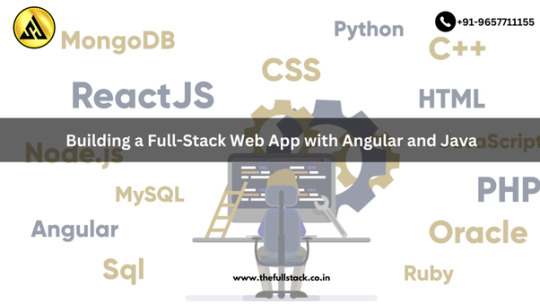
Learn how to build a full-stack web application using Angular for the frontend and Java with Spring Boot for the backend. This hands-on guide covers modern web development practices including RESTful API integration, responsive UI design, and secure user authentication. Whether you’re a beginner or an intermediate developer, this full-stack development tutorial helps you master component-based architecture, real-time data binding, and scalable backend services. Discover how to deploy your application with Docker and integrate it with cloud platforms. Start your journey into high-demand technologies like Angular, Java, Spring Boot, and MySQL to create dynamic and enterprise-grade web apps
0 notes
Text
Certified DevSecOps Professional: Career Path, Salary & Skills
Introduction
As the demand for secure, agile software development continues to rise, the role of a Certified DevSecOps Professional has become critical in modern IT environments. Organizations today are rapidly adopting DevSecOps to shift security left in the software development lifecycle. This shift means security is no longer an afterthought—it is integrated from the beginning. Whether you're just exploring the DevSecOps tutorial for beginners or looking to level up with a professional certification, understanding the career landscape, salary potential, and required skills can help you plan your next move.
This comprehensive guide explores the journey of becoming a Certified DevSecOps Professional, the skills you'll need, the career opportunities available, and the average salary you can expect. Let’s dive into the practical and professional aspects that make DevSecOps one of the most in-demand IT specialties in 2025 and beyond.
What Is DevSecOps?
Integrating Security into DevOps
DevSecOps is the practice of integrating security into every phase of the DevOps pipeline. Traditional security processes often occur at the end of development, leading to delays and vulnerabilities. DevSecOps introduces security checks early in development, making applications more secure and compliant from the start.
The Goal of DevSecOps
The ultimate goal is to create a culture where development, security, and operations teams collaborate to deliver secure and high-quality software faster. DevSecOps emphasizes automation, continuous integration, continuous delivery (CI/CD), and proactive risk management.
Why Choose a Career as a Certified DevSecOps Professional?
High Demand and Job Security
The need for DevSecOps professionals is growing fast. According to a Cybersecurity Ventures report, there will be 3.5 million unfilled cybersecurity jobs globally by 2025. Many of these roles demand DevSecOps expertise.
Lucrative Salary Packages
Because of the specialized skill set required, DevSecOps professionals are among the highest-paid tech roles. Salaries can range from $110,000 to $180,000 annually depending on experience, location, and industry.
Career Versatility
This role opens up diverse paths such as:
Application Security Engineer
DevSecOps Architect
Cloud Security Engineer
Security Automation Engineer
Roles and Responsibilities of a DevSecOps Professional
Core Responsibilities
Integrate security tools and practices into CI/CD pipelines
Perform threat modeling and vulnerability scanning
Automate compliance and security policies
Conduct security code reviews
Monitor runtime environments for suspicious activities
Collaboration
A Certified DevSecOps Professional acts as a bridge between development, operations, and security teams. Strong communication skills are crucial to ensure secure, efficient, and fast software delivery.
Skills Required to Become a Certified DevSecOps Professional
Technical Skills
Scripting Languages: Bash, Python, or PowerShell
Configuration Management: Ansible, Chef, or Puppet
CI/CD Tools: Jenkins, GitLab CI, CircleCI
Containerization: Docker, Kubernetes
Security Tools: SonarQube, Checkmarx, OWASP ZAP, Aqua Security
Cloud Platforms: AWS, Azure, Google Cloud
Soft Skills
Problem-solving
Collaboration
Communication
Time Management
DevSecOps Tutorial for Beginners: A Step-by-Step Guide
Step 1: Understand the Basics of DevOps
Before diving into DevSecOps, make sure you're clear on DevOps principles, including CI/CD, infrastructure as code, and agile development.
Step 2: Learn Security Fundamentals
Study foundational cybersecurity concepts like threat modeling, encryption, authentication, and access control.
Step 3: Get Hands-On With Tools
Use open-source tools to practice integrating security into DevOps pipelines:
# Example: Running a static analysis scan with SonarQube
sonar-scanner \
-Dsonar.projectKey=myapp \
-Dsonar.sources=. \
-Dsonar.host.url=http://localhost:9000 \
-Dsonar.login=your_token
Step 4: Build Your Own Secure CI/CD Pipeline
Practice creating pipelines with Jenkins or GitLab CI that include steps for:
Static Code Analysis
Dependency Checking
Container Image Scanning
Step 5: Monitor and Respond
Set up tools like Prometheus and Grafana to monitor your applications and detect anomalies.
Certification Paths for DevSecOps
Popular Certifications
Certified DevSecOps Professional
Certified Kubernetes Security Specialist (CKS)
AWS Certified Security - Specialty
GIAC Cloud Security Automation (GCSA)
Exam Topics Typically Include:
Security in CI/CD
Secure Infrastructure as Code
Cloud-native Security Practices
Secure Coding Practices
Salary Outlook for DevSecOps Professionals
Salary by Experience
Entry-Level: $95,000 - $115,000
Mid-Level: $120,000 - $140,000
Senior-Level: $145,000 - $180,000+
Salary by Location
USA: Highest average salaries, especially in tech hubs like San Francisco, Austin, and New York.
India: ₹9 LPA to ₹30+ LPA depending on experience.
Europe: €70,000 - €120,000 depending on country.
Real-World Example: How Companies Use DevSecOps
Case Study: DevSecOps at a Fintech Startup
A fintech company integrated DevSecOps tools like Snyk, Jenkins, and Kubernetes to secure their microservices architecture. They reduced vulnerabilities by 60% in just three months while speeding up deployments by 40%.
Key Takeaways
Early threat detection saves time and cost
Automated pipelines improve consistency and compliance
Developers take ownership of code security
Challenges in DevSecOps and How to Overcome Them
Cultural Resistance
Solution: Conduct training and workshops to foster collaboration between teams.
Tool Integration
Solution: Choose tools that support REST APIs and offer strong documentation.
Skill Gaps
Solution: Continuous learning and upskilling through real-world projects and sandbox environments.
Career Roadmap: From Beginner to Expert
Beginner Level
Understand DevSecOps concepts
Explore basic tools and scripting
Start with a DevSecOps tutorial for beginners
Intermediate Level
Build and manage secure CI/CD pipelines
Gain practical experience with container security and cloud security
Advanced Level
Architect secure cloud infrastructure
Lead DevSecOps adoption in organizations
Mentor junior engineers
Conclusion
The future of software development is secure, agile, and automated—and that means DevSecOps. Becoming a Certified DevSecOps Professional offers not only job security and high salaries but also the chance to play a vital role in creating safer digital ecosystems. Whether you’re following a DevSecOps tutorial for beginners or advancing into certification prep, this career path is both rewarding and future-proof.
Take the first step today: Start learning, start practicing, and aim for certification!
1 note
·
View note
Text
Deploy Machine Learning Models with Flask and Docker
1. Introduction 1.1 Overview Machine learning model deployment is a crucial step in the ML lifecycle, transforming models from development environments to production. Flask, a lightweight Python web framework, is ideal for building APIs to serve models. Docker, a containerization platform, ensures consistent deployment across environments. This tutorial guides you through deploying an ML model…
0 notes